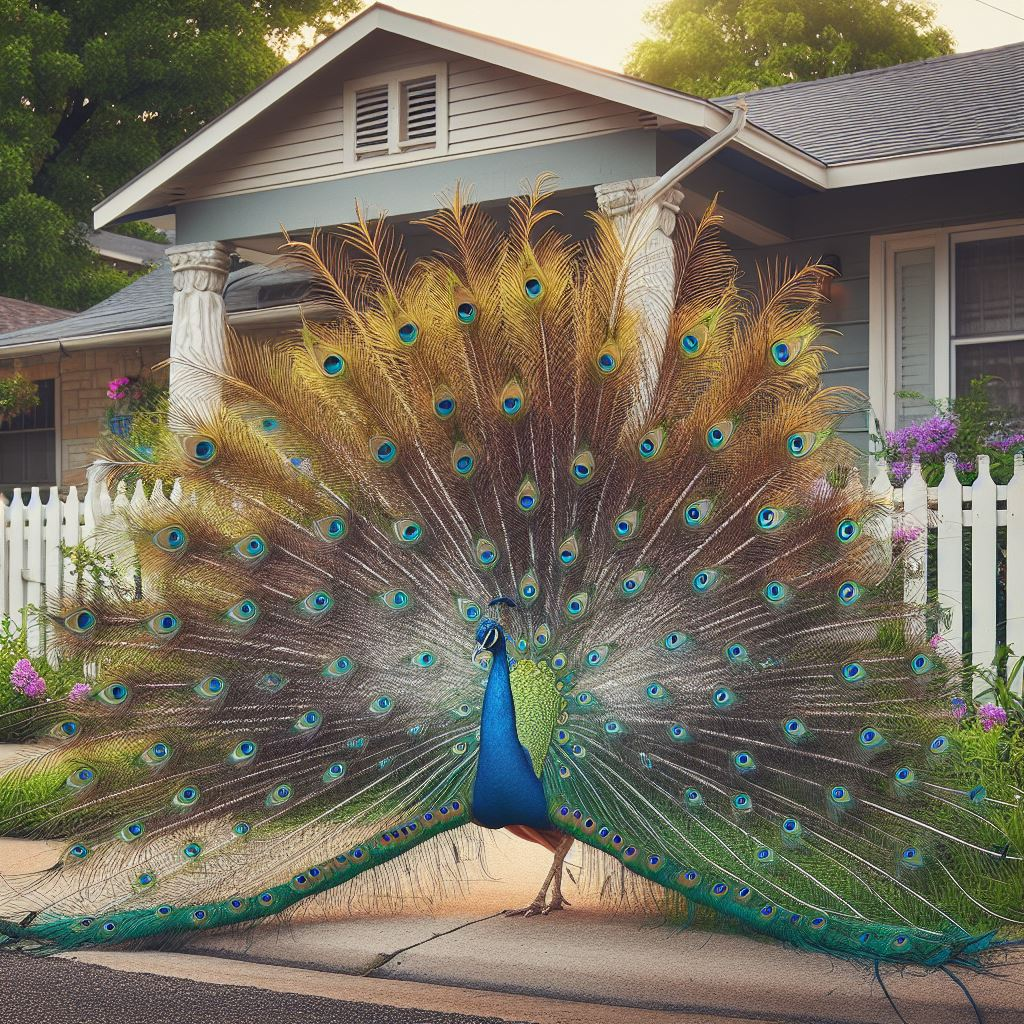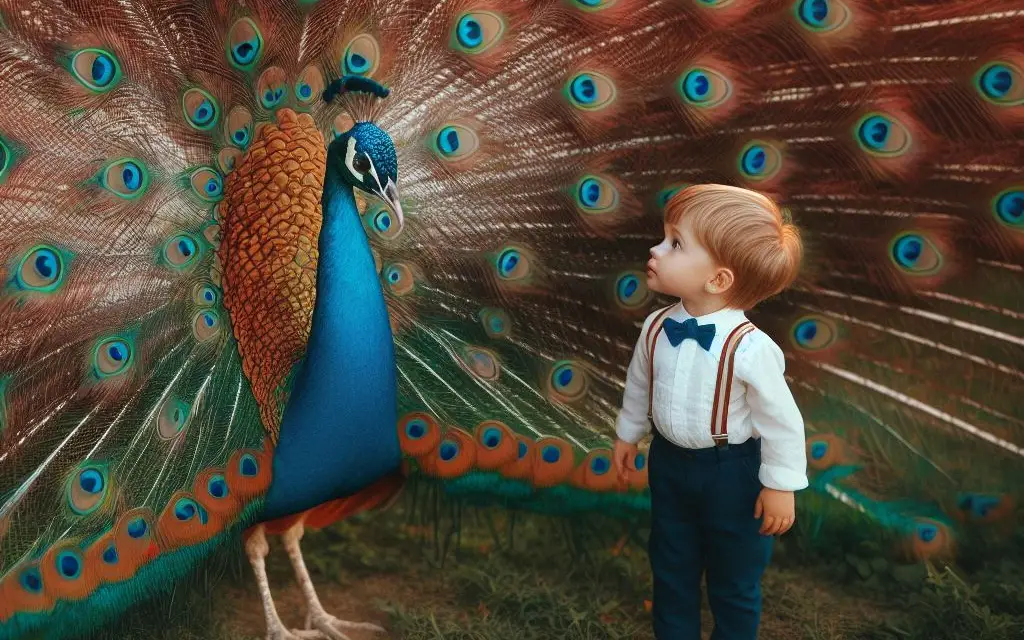Peacocks, with their vibrant plumage and piercing calls, have captivated people for centuries. While often associated with zoos, estates, and parks, some people wonder if peacocks can be kept as personal pets. As exotic birds, peacocks require special care and considerations before bringing one home.
While their regal appearance intrigues many animal lovers, peacocks remain unrealistic pets for most people due to their extensive care requirements, proclivity for ear-piercing vocalizations, potential conflicts with zoning laws or community rules, and overall challenging husbandry needs – prospective peacock owners must carefully assess if they can provide adequate facilities, diet, health maintenance, time commitments and an appropriate rural setting before taking on one of these exotic birds as a pet.
The Allure and Challenges of Pet Peacocks
A peacock spreading its emerald and azure train can certainly create a majestic sight in any backyard. Their unique vocalizations also add character to a homestead. However, peacocks have extensive needs as livestock that preclude many people from keeping them. From housing to diet to legal restrictions, this article explores the realities behind owning a pet peacock.
Assessing If a Peacock Is the Right Pet
Peacocks remain uncommon as personal pets, largely due to the extensive commitments they require. Before acquiring a peacock, carefully research local laws, prepare proper housing, budget for care/feeding costs, and ensure adequate time for daily attention. While rewarding for the right homes, peacocks have considerable needs unsuited for many owners.
Housing Requirements for Pet Peacocks
One major consideration for pet peacock owners involves establishing proper housing. Both enclosure size and features require attention to keep peacocks healthy and content.
Enclosure Size
Peacocks range extensively when allowed and need adequate space. Each peacock needs a minimum of 1,000 square feet of outdoor space for roaming. The enclosure should also have a covered shelter for nesting and retreats from bad weather. Young peacocks may be kept indoors but require an outside enclosure upon maturity.
Enclosure Features and Setup
The peacock enclosure requires certain features to aid natural behaviors. These include:
- Perches – Placed at various heights for roosting
- Nesting area – A sheltered space filled with straw bedding
- Pools – Shallow pools for bathing and feather maintenance
- Substrate – Natural dirt, sand, or grass terrain preferred
The enclosure should have fence sides 8-10 feet high, as peacocks can injure themselves in low walls with their cumbersome trains. The top of the enclosure should also have netting to keep birds from escaping or falling prey to predators.

Dietary Needs of Pet Peacocks
Providing a nutritious diet is vital for any pet, and peacocks have unique nutritional requirements.
Natural Diet
In the wild, peacocks are omnivores who eat a varied combination of plant and animal matter. Their diet naturally includes:
- Grains and seed heads
- Fruits and berries
- Flower buds/petals
- Insects like crickets and mealworms
- Small amphibians and reptiles
Captive Diet
In captivity, peacocks thrive best on specialized commercial diets formulated for gamebirds. These pelleted feeds supply balanced nutrition. Supplements can enhance the diet, including:
- Chopped fruits/vegetables
- Cooked eggs with shell
- Live insects like mealworms
- Small amounts of unsalted popcorn or nuts
Providing peacocks whole corn, bread, or table scraps can lead to nutritional disorders. Fresh water should be available at all times in clean containers.
Proper Climate for a Peacock
As tropical and subtropical birds, peacocks require mild temperatures and are prone to heat or cold extremes. They thrive best in warmer temperate regions where seasonal lows stay above freezing. Though peacocks can acclimate to colder locations if provided warm winter shelter, areas with extreme sustained cold or frequent snow/ice pose health risks.
Ideally, the climate for raising peacocks as pets should feature summer highs no hotter than 90 ̊F to avoid heat stress. Their enclosures need cooling shade and adequate airflow. At the other extreme, winter lows between 30-40 ̊F represent the thresholds peacocks can withstand while staying healthy. Owners in northern areas must furnish a well-insulated, draft-free shelter for cold months. Climate change bringing increased weather extremes may also impact an area’s suitability for keeping peacocks in upcoming decades. Checking the historical regional temperatures and adjusting facilities accordingly allows the best results.

General Peacock Care and Handling
Beyond basic necessities, peacocks have additional care needs as uncommon pets. Maintaining their health and disposition requires attention from owners.
Grooming
Peacocks meticulously tend their plumage themselves through preening gland oils. However, owners should provide a shallow pool for occasional bathing. Periodic spraying with a hose also helps manage normal feather shedding. Overgrown claws may need periodic trimming as well.
Socialization
Peacocks naturally live in small flocks and appreciate — even need — regular attention from owners for behavioral well-being. Hand-taming them from a young age allows handling for health checks. Even older birds not amenable to touching will interact through chatting, eating treats together, or simple companionship.

Health Concerns
Nutritional issues and parasites pose the main health threats to pet peacocks. Annual exams and prompt treatment when ill help ensure a long, healthy life. Common ailments involve plant toxicosis, frostbite, roundworms, and coccidiosis. Life spans average 10-15 years.
Noisy Vocalizing
The loud, frequent calls of peacocks rank as the top nuisance complaint among owners. Their abrasive screams, especially during breeding season, carry for acres and commonly bring neighbors’ complaints. Rural locations offer the only realistic home settings for most people, as their vocal nature simply doesn’t suit suburbia.
Legal and Zoning Issues with Pet Peacocks
Local laws represent one of the main challenges facing would-be peacock owners. Regulations often prohibit exotic species as pets or livestock within city boundaries.
Local Ordinances
Many urban and suburban regions expressly forbid owning peacocks and other exotic animals. Even rural counties enforce zoning restrictions against farm animals. Check all state and local ordinances thoroughly before acquiring a peacock.
Permits and Licenses
Some areas may allow peacocks only under special permits, such as agricultural zoning exceptions. This usually requires permits and inspections to ensure proper facilities. Annual licenses specifically for keeping peacocks also apply in certain jurisdictions. Failure to comply could lead to confiscation or fines.
Homeowner Bans
Beyond law codes, many housing developments, multi-family units, and neighborhoods forbid peacocks under HOA rules or rental contracts. The noise, damages, and insurance liability issues they pose allow communities to prohibit peacock ownership outright regardless of broader laws.
To highlight the main points on keeping peacocks as pets, here is a helpful table:
| Consideration | Description |
|---|---|
| Enclosure Size | Minimum 1,000 sq. feet outdoor space |
| Enclosure Features | Perches, shelter, pools, 10 ft fencing, netted top |
| Diet | Commercial gamebird diets, fruits/veggies, insects, supplements |
| Grooming | Provide bathing pools, trim overgrown claws |
| Socialization | Regular human interaction, hand-taming ideally |
| Health Issues | Nutrition disorders, parasites, infections, frostbite |
| Noise Factor | Loud, frequent screams carry over distances |
| Legal Issues | Local bans, permits required, inspections |

Conclusion:
Keys for Successful Pet Peacock Care
Peacocks offer captivating exotic animal appeal, but practical hurdles limit their feasibility as pets for most owners. Providing adequate space, diet, facilities, time, and legal allowances challenges even experienced handlers. While special homes willing to accommodate their extensive needs can find reward in keeping peacocks, they don’t suit most people as pets. Careful consideration of the realities can help determine if owning a peacock matches your lifestyle and resources.
Frequently Asked Questions
How much does a pet peacock cost?
A pet peacock costs $200-500 for the bird itself. However, preparing proper housing and maintaining care often exceeds $2,000+ over its lifetime.
What health problems do pet peacocks have?
Common health issues include plant poisoning, intestinal parasites, bacterial infections, frostbite, aggression injuries, and foot problems. Providing balanced diet and nutrition helps avoid disorders.
Do pet peacocks get along with other animals?
Peacocks naturally mesh well with other barnyard birds like chickens, geese, and ducks when raised together. However, their sharp claws and beaks pose risk for harming smaller animals if provoked.
How long do pet peacocks live?
In captivity with proper care, peacocks generally live 10-15 years on average. The oldest recorded lifespans reach 25 years for exceptional specimens.
Can peacocks be house pets?
While peacock chicks under 12 weeks old can be housed indoors, adults simply grow too large, noisy, and destructive to dwell solely inside a home. They require outdoor enclosures once mature.
If you enjoyed reading this article, please check out Can I Keep A Cardinal As A Pet?

My name is Shane Warren, the author behind Your Bird Buddy – your ultimate guide to the wonderful world of birds! Unleash your inner avian explorer as we delve into a vibrant library of knowledge dedicated to all things feathered. From learning about diverse bird species from across the globe to understanding their captivating habitats and behaviors, I’m here to fuel your passion for these magnificent creatures. Not only that, but I also provide valuable insights on being a responsible and informed pet bird owner. Join our vibrant community and let’s celebrate the feathered wonders of the world together – one chirp at a time. And be sure to join our Your Bird Buddy Community over on Facebook!


Comments are closed